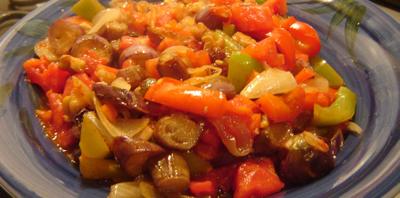
The new
Milwaukee Public Market doesn't actually open for a month, but an adjacent outdoor farmer's market has been open for several weeks and I headed down there this morning expecting to be impressed. The market is a
$10 million project--partly federally financed--in the works for the past half decade. It is intended, in the words of our senior United States senator, to be "an important part of Milwaukee's downtown revitalization." It is situated adjacent to the Third Ward, Milwaukee's wannabe-SoHo. One excited blogger puts its design in the category of
"beyond brilliance".
Beyond Brilliance likes best the way the new market makes use of an adjacent freeway underpass, claiming otherwise unusable space and making it part of a "revitalization." BB, you might have waited until the market actually opened before thus opining. There is a reason most cities' freeway underpasses are unusable--they are noisy, dark, often dirty and smelly, uninviting spaces. By plunking the farmer's market down under Interstate 794, the planners of this project have made the whole enterprise less likely to succeed. Here is what I saw when I pulled up to a parking meter across the street from our new market:

Behind me as I took this shot was a construction crew working on a long-term freeway improvement project. The noise was awful. Cars sped past in both directions, making crossing the street a bit Froggeresque. Busses pass frequently, bringing more racket and billowing exhaust. [
Update: the exhaust doesn't really billow; I was getting carried away. Sorry about that.] One of the worst things to happen to big cities in the twentieth century was the threading of large highways through their downtowns and Milwaukee suffers along with the rest. (Freeway construction was especially damaging here for its role in
shattering the African-American community.) I don't see how setting up seasonal businesses in these dead zones makes any sense. As you can see, they have constructed steel awnings to give the space a more human scale. But that's not enough to make it inviting.
Shopping under I-794 is no one's idea of fun. Today is brilliantly sunny and warm, a lovely late summer day. But this is what it looked like at our new market.

The selection of vendors is small, and their produce less copious than at most local markets. No one was selling cheese, a staple of Wisconsin agriculture, and no one was selling meats, fish, jams, or honey, which are also mainstays of markets around here. Thankfully, C. Adam's bakery (which I have praised in a past
post) was set up with its fantastic buns. This time I tried their pesto-sun-dried-tomato flavor, which is just outrageous. I would gladly eat one of these every day.
What upset me most about the market was its lack of a scene. Great markets are public spaces in the sense that the public congregates in them, they become hives of human activity. I know it just opened, but this is Milwaukee and the public here rarely congregates anywhere except bars and malls. Some markets do attract crowds but not this one yet. Consider two great public markets that I've been to: the Dane County Farmer's Market in Madison (picture from
this site)

and the Haymarket in Boston (picture from
this site)

What strikes me as I look at these pictures isn't the produce for sale; it's the people. These markets conceived and designed to teem with people. They are first of all pleasant open-air spaces. It used to bug me in Madison that most of the people at the market were there for reasons other than buying vegetables, but that is actually what makes it such as fantastic public space. It's a scene where Madisonians go to be amongst Madisonians.
This illustration of what the Milwaukee market is intended to be like is rather hopeful (it's from Beyond Brilliance).

Notice there are no cars but lots of pedestrians. Also notice the crosswalks painted on the street. Neither the pedestrians nor the crosswalks were there today, but plenty of noisy busses passed.
Now here's what really gets me: there are two perfect spots for this farmer's market sitting a stone's throw from where it now stands. The south face of the new building is completely unused as of yet.

At least it's open-air and quiet along this street. Then there's this newly constructed park
right across the street. Not a soul in it for the entire time I was down there today. This is just sad.

I do have one nice thing to say about the Milwaukee Public Market: it has a great sign.

As our friend Gwynne pointed out, it is clearly an homage to Pike Place in Seattle (picture from
this site).

If the inside part of our market reaches anywhere near the heights of
Pike Place, we'll be very lucky.
Well, it's only a beginning. I hope this story takes a turn for the happy. But it will take more than some vegetables for sale under an expressway to bring Brew City out into the streets.
UPDATE: For a fantastic compendium of great public markets, see
Project for Public Spaces.






















































